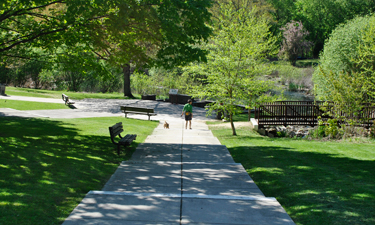 Fairmount Park is a leafy oasis in the middle of sprawling metropolitan Philadelphia. Philadelphians of all stripes seek out its tree-lined paths and open areas to exercise, picnic or watch the world go by. But Fairmount Park is also a critical piece of municipal infrastructure soaking up millions of gallons of stormwater each year, relieving the city’s overtaxed stormwater system and reducing combined sewer overflows into the Schuylkill and Delaware Rivers (visit "Greener Parks for Cleaner Waters" for more information on Philadelphia parks’ role in the city’s stormwater management system). Fairmount Park is an example of green infrastructure, and green infrastructure is having huge impact in how cities not only manage polluted stormwater runoff, but also create vibrant, sustainable infrastructure on every block.
Fairmount Park is a leafy oasis in the middle of sprawling metropolitan Philadelphia. Philadelphians of all stripes seek out its tree-lined paths and open areas to exercise, picnic or watch the world go by. But Fairmount Park is also a critical piece of municipal infrastructure soaking up millions of gallons of stormwater each year, relieving the city’s overtaxed stormwater system and reducing combined sewer overflows into the Schuylkill and Delaware Rivers (visit "Greener Parks for Cleaner Waters" for more information on Philadelphia parks’ role in the city’s stormwater management system). Fairmount Park is an example of green infrastructure, and green infrastructure is having huge impact in how cities not only manage polluted stormwater runoff, but also create vibrant, sustainable infrastructure on every block.
Green infrastructure has the potential to help communities reshape their growth and development, including reinvigorating distressed neighborhoods. In cities and towns across the country, parks, schoolyards, leafy green “complete streets” and green roofs not only manage stormwater, but also clean the air, cool our neighborhoods, increase property values and catalyze development. In cities across the country, innovative city leaders, designers and community members are banding together to integrate green infrastructure and growth into the fabric of their neighborhoods.
Legislation soon to be introduced in the U.S. House and Senate has the potential to help arm park and recreation agencies with information and resources on how to best utilize your green infrastructure networks to help manage your community’s stormwater runoff. This fall, Rep. Donna Edwards (D-Md.) and Sen. Tom Udall (D-N.M.) are working to introduce the Innovative Stormwater Infrastructure Act.
This bill will help provide communities and park and recreation leaders with the data and best practices to help evaluate how green infrastructure techniques may apply in their contexts. If approved, the Innovative Stormwater Infrastructure Act will provide grants to communities to implement green infrastructure projects that effectively and sustainably manage stormwater runoff. It will also create up to five Centers of Excellence that will provide regionally specific data, best practices and models for local governments, park and recreation professionals, and the private sector to pursue innovative ways to address stormwater infrastructure in their communities.
This bill will help address the national need for data and best practices for the innovative and sustainable management of stormwater runoff, one of the largest sources of pollutants in our nation’s water bodies. Regulation will continue to require cities to manage and clean polluted stormwater runoff, and the cost savings achieved by green infrastructure approaches can be significant. NRPA and the American Society of Landscape Architects (ASLA) are working as part of a coalition including the National Association of Clean Water Agencies, American Rivers, the Natural Resources Defense Council, the Water Environment Federation (WEF) and others to advance this legislation.
ASLA recently collected more than 475 green infrastructure case studies from 43 states, the District of Columbia and Canada. These case studies showed that green infrastructure approaches are widespread and are being implemented in the public, private and institutional settings. An analysis of these case studies showed that in more than 75 percent of the projects, green infrastructure approaches either reduced costs or had no effect on overall project cost. The case-study effort and the associated data led to the commission of a report: Banking on Green: How Green Infrastructure Saves Municipalities Money and Provides Economic Benefits Community-wide. The report released by ASLA, American Rivers, WEF and ECONorthwest found that green infrastructure can:
- Cost less, and further reduce the costs of treating large amounts of polluted runoff;
- Help municipalities reduce energy expenses;
- Reduce flooding and related flood damage; and
- Improve public health by reducing bacteria and pollution in rivers and streams, preventing gastrointestinal illnesses in swimmers and boaters.
A Trust for Public Land report estimates that, in 2007, the value of the stormwater runoff captured by the City of Philadelphia’s park system was nearly $6 million, and Philadelphia is aggressively moving forward in using green infrastructure to comply with Clean Water Act requirements. Similarly, the City of New York is planning to spend $1.6 billion in the next 20 years on green infrastructure approaches to stormwater management. The District of Columbia is developing a stormwater credit-trading mechanism that would allow parcels of land that retain stormwater onsite to sell their credits on an open market. As park and recreation professionals know, their facilities are tremendous resources for the public, providing a myriad of benefits for their surrounding communities. Stormwater management provides a terrific opportunity for park and recreation professionals to continue to lead in their communities, and this legislation will help provide grants, data, and best practices to allow them to do so.
Kevin O’Hara is the Manager of Government Affairs for the American Society of Landscape Architects.

